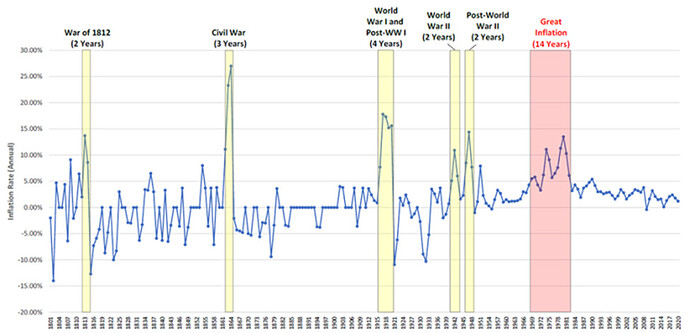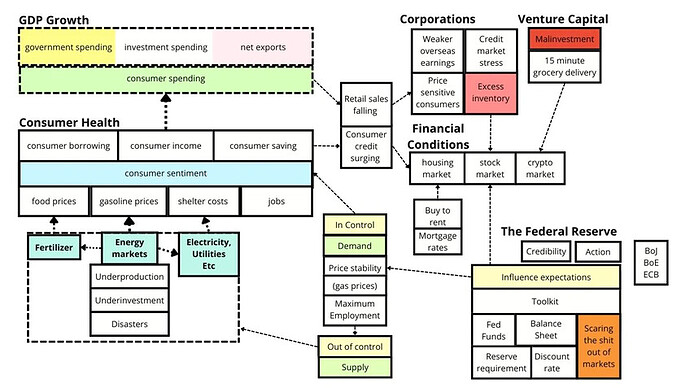Fed’s not joking this time around
This paper by Mark J. Higgins explains that the US has experienced periods of high inflation lasting longer than a year just six times since 1800. Here’s a chart from the piece showing the US inflation rate from 1800 to 2020.
Back then, economists believed there was a trade-off between inflation and unemployment. Lower unemployment could be achieved in exchange for slightly higher inflation. When unemployment fell below its usual rate, it created a new path of expected inflation, and unemployment rates eventually returned to previous levels. However, it is different this time.
The paper explains about the Upside down Depression. Mark says we should prepare for monetary tightening that will persist until prices stabilize. This is hard to think about without a strong recession and further market downfall.
People are What Matters, Actually
“It seems more and more that everything is a balancing act, existing in the tail end of extremes, and the slightest touch can tip the whole scale. There is a lot going on! People will often describe markets as dominoes - one thing falls, and everything else goes down with it.”
There are various frameworks to examine the economy. But at the centre stage of every policy decision is the people because it is the consumer spending, or the people that drive the wheel of the economy. As the below chart illustrates;
This is a comprehensive look at the economy through the context of people.
India - the world’s next economic motor?
In April the IMF reckoned that Indian GDP might grow by more than 9% this year—easily the fastest pace among large countries. Such a rapid expansion, if sustained, would have a profound impact on the world.
China accounted for nearly a third of global growth—more than America and the European Union combined in the 2000s and by 2010 China’s contribution had roughly doubled, and its share of global goods exports rose from 4% to 13%.
With a large English-speaking population, a democratic political system and being a thriving exporter of tech and business services could India be taking up China’s mantle and have the world economy revolve around us?
This article compares India’s current situation to where China stood two decades ago in terms of growth rate and output to answer.
Influencers and the crypto hype
Did your favourite influencer or personality share any tweets, feeds, Stories, Reels, or YouTube videos about cryptocurrencies? If your answer is yes, you should definitely read this.
One of the saddest things that has happened and is still happening is that influencers are endorsing a high-risk, extremely volatile asset class. Claiming that this is a sure thing that makes us wealthy.
Everyone from gen-z, millennials, and almost everyone who is constantly connected to the internet has undoubtedly heard of crypto, bitcoin, dogecoin, blah, blah, young millionaire, blah, Elon, and all the other exaggerated statements made by these influencers.
If you recall, it was during the pandemic period, that the popularity of cryptocurrency lured many of us who were stuck at home with free time to look into it in the hopes of making an extra buck or becoming wealthy by investing in it. With crypto’s popularity comes influencers promoting it to the masses as it is suitable for everyone and claiming that they, too, are investing heavily in it.
The present situation is that the entire crypto crash has made everyone talk less about crypto, the dubious crypto coins, and their platforms. The popular Bitcoin, Ethereum, and Dogecoin are down more than 60% year to date. The majority of the cryptocurrencies were scams, pure pump, and dump schemes. Many crypto entrepreneurs hired these influencers to speculate the price movements.
Here’s an article from the New York Times on how influencers like Floyd Mayweather, Kim Kardashian, and Logan Paul have made millions of dollars by endorsing crypto investments.
The Survival Instinct of Money
There’s nothing in this world that stresses out people more than money. And this is on both sides of the spectrum. For those who have it, it is about preservation. For those who don’t, it is about growth.
“Due to its ubiquity, money is tied in with so many things that are independent of the goods and services it could buy. It acts as a signal for one’s reputation, one’s social status, and the commanding of one’s respect. It not only shifts the social dynamics we share with others, but it can also shift the perceptions we have of ourselves.
If your basic necessities are covered, how is it that money can still trigger a stress response that’s indistinguishable from a real biological fear? Why is it that having enough money doesn’t just alleviate this fear, but often has the opposite effect of strengthening it?”
What to watch;
Stan Druckenmiller and John Collison, co-founder of Stripe talk about the markets, the economy, and his investment philosophy.
What to listen;


